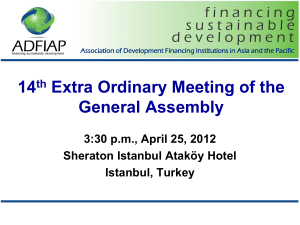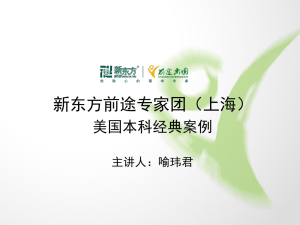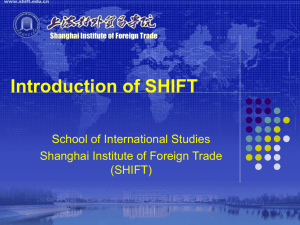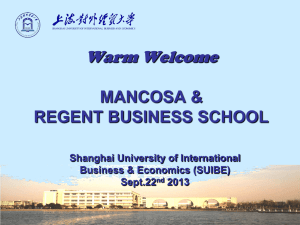The Business Case for Green Governance
advertisement
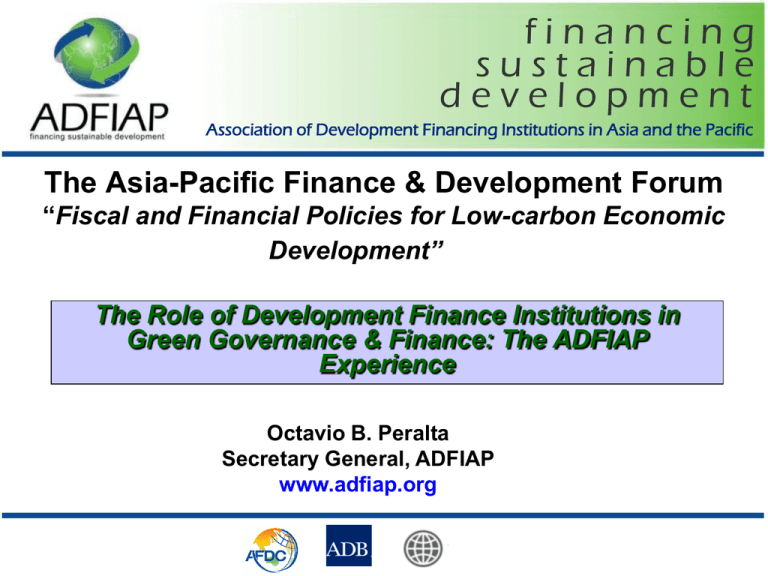
financing sustainable development Association of Development Financing Institutions in Asia and the Pacific The Asia-Pacific Finance & Development Forum “Fiscal and Financial Policies for Low-carbon Economic Development” The Role of Development Finance Institutions in Green Governance & Finance: The ADFIAP Experience Octavio B. Peralta Secretary General, ADFIAP www.adfiap.org AGENDA ADFIAP and its Mission The Need for and Role of DFIs The Business Case for Green Governance ADFIAP & DFIs: Case Studies on Green Finance Green Governance Initiative Concluding Remarks Asia-Pacific Finance & Development Forum, November 26, 2010, Shanghai, China Introducing…ADFIAP Asso. of Development Financing Institutions in Asia & the Pacific 120 member-institutions in 43 countries & territories Founded in 1976 during the 6th ADB conference for DFIs Founding member & Secretariat of the World Federation of DFIs An NGO in consultative status with the UN ECOSOC Member, UNEP Finance Initiative Asia-Pacific Task Force EU-Asia Pro Eco Programme grantee on Environmental Governance 2008 Winner of ASAE’s Associations Make a Better World Award Permanent secretariat is in Manila, Philippines Asia-Pacific Finance & Development Forum, November 26, 2010, Shanghai, China ADFIAP’s Mission & Focus Areas “Financing Sustainable Development” •MSMEs •Trade •Agriculture •Industry •Technology •Infrastructure •Services •Financial Inclusion •Social Housing •Education & Health Economic Social Governance •Climate change •Environment finance •CDM •Carbon finance •Others Environment •Corporate Governance •Institutional Integrity Mission & Focused Areas ADFIAP’s Sustainable Development Pillars Sustainable Development Good Governance Environmental Finance SME Finance Social Finance Asia-Pacific Finance & Development Forum, November 26, 2010, Shanghai, China DFI vis-à-vis DB A Development Financing Institution (DFI) connotes a broader term since not all DFIs are “banks” per se. However, alternatively and for ease of terminology, it can also be referred to as a “development bank.” Asia-Pacific Finance & Development Forum, November 26, 2010, Shanghai, China The Need for Development Banks 1 Need for an “special purpose institution” 2 Need to provide financing to the to accelerate long-term investments to create employment and achieve rapid national growth. “engines of growth” to achieve a higher degree of productivity and efficiency in the economy. 3 Commercial banks are usually contented 4 A case of “market failure” requiring with short-term banking activities and are reluctant or are not in a position to support national priorities of long-term investment in the real sectors. national governments to intervene in the financial markets. The underlying principle is that long-term resource allocation should be done by businessoriented financial institutions vis-à-vis direct allocation by the government. Asia-Pacific Finance & Development Forum, November 26, 2010, Shanghai, China Roles of a Development Bank Initiator Plays a “supplyleading” role (in anticipation of future demand) e.g., technology transfer, strategic industries, environmental projects InstitutionBuilder Develops new methodologies & systems in raising capital & increasing investments through nontraditional areas, e.g., financing large projects via BOT, BOL, BOO, etc.; capital market; microfinance Catalyst Takes a lead role in creating new financial packages with involvement of banks & other financial institutions, e.g., loan syndication of large projects; guarantee schemes for industry sectors Development Advocate Bank of Last Resort Promotes the ‘business’ of development such as job generation, domestic resource mobilization, country-side development, MSMEs Assists projects that no other financial institution will fund, thus promoting new & innovative economic activities, e.g., funding for inventors, cooperatives and high-risk investments Asia-Pacific Finance & Development Forum, November 26, 2010, Shanghai, China Institutional Linkages of a Development Bank Regulatory Body • Capital • Enabling policy Institutional Strengthening Loan T.A. Project Proponent Government F/S Repay • Dividend • Development advice Repayment DEVELOPMENT BANK IFIs Funds Capital Markets Loan • job creation • earnings • technology transfer • other economic benefits • Repayment • Participant • Wholesale Loans • Syndication Commercial Banks Info/ support Project Ideas Public / Private Sector Financial Institutions Asia-Pacific Finance & Development Forum, November 26, 2010, Shanghai, China General Types of Development Banks Today policy banks – directly support the national government’s economic policy plans & directions. Ex. China, Malaysia, etc. special-purpose DBs – support focused sectors of the economy. Ex. SME Bank Thailand, Agro Bank Malaysia, Housing Bank India, etc. multi-purpose DBs – also called “universal banks” – support both development projects as well as commercial businesses. Ex. Philippines, India, Sri Lanka, etc. commercially-oriented DBs – support development through commercial banking services. Ex. Singapore Asia-Pacific Finance & Development Forum, November 26, 2010, Shanghai, China The Business Case for Green Governance Climate change effects on business organizations As early as 2006, a report analysing greenhouse gas emissions of the 500 world’s largest publicly-traded companies found that businesses will not be immune to the predicted changes and may experience disturbance to their operations and profitability. Asia-Pacific Finance & Development Forum, November 26, 2010, Shanghai, China The Business Case for Green Governance Climate change effects on business organizations it makes good business sense for business organizations to start accounting for their own greenhouse gas emissions, according to a report issued by the World Resources Institute. The benefits include: - identifying reduction & subsequent money-saving opportunities; - cutting the company’s regulatory risks that may result from more stringent regional, national, or international efforts to curb global warming; and - enhancing reputational status in the eyes of the consumers and other stakeholders. Asia-Pacific Finance & Development Forum, November 26, 2010, Shanghai, China The Business Case for Green Governance Direct financial gains • cost savings (in energy/water use, paper, etc.) • cost-consciousness among employees • lower future compliance costs Reputational/Image benefits • attract & retain customers • attract & retain good employees • better recognition in society & public in general Work place benefits • proper facility management • accident-free environment • healthier working environment Environmental/Ecological Gains • clean environmental services & access to natural resources Asia-Pacific Finance & Development Forum, November 26, 2010, Shanghai, China The Business Case for Green Governance Being a value-driven company Tangible value drivers: Profitability reductions in resource use, health and safety excellence, responsibility beyond compliance, environmental performance measurement, sustainability communication Asset utilization Service quality Shareholder value creation Intangible value drivers: Customer relationships Brand equity & reputation Stakeholder interests on the company‘s products & services Alliances Source: GEMI Technology Asia-Pacific Finance & Development Forum, November 26, 2010, Shanghai, China Starting from within: The Environmental Governance Project www.egs-asia.com The issue of environmental governance has been and will always be in the forefront of ADFIAP’s activities. ADFIAP’s “Greening of DFIs” Project is its collective and responsive effort to pursue sustainable development through its adherence to the principles of a safe and clean environment, not only as part of good corporate citizenship, but more importantly, as an integral part of sound business practice. - ADFIAP Board of Directors •About 300 CEOs and senior staff were involved in the project in ADFIAP regional, sub-regional and national meetings & conferences; •A new ADFIAP publication, Greenbank, was developed and produced for dissemination to members and other networks; and •An Environmental Category has since been included in the annual ADFIAP Awards program for outstanding achievements of member banks. Asia-Pacific Finance & Development Forum, November 26, 2010, Shanghai, China Starting from within: The “Greening of DFIs” Project Sustainability Report 2009 Water Financing Carbon Offset Certificate Green Banking Book Launch Project Partners Asia-Pacific Finance & Development Forum, November 26, 2010, Shanghai, China www.devbankphil.com.ph DBP Forest: Greening the countryside Clean Development Mechanism* (CDM): The CDM is an arrangement under the Kyoto Protocol which allows industrialized countries with a greenhouse gas reduction commitment to invest in initiatives that lessen emissions in developing countries as an alternative to more costly emission reduction measures. Environmental Development Project* (EDP) Local government units, government-owned and controlled corporations, cooperatives, water districts, private corporations and private water service providers can access long-term funds through DBP and its participating financial institutions to mobilize, encourage, and support activities and investments in environment-friendly projects. * With the Japan Bank for International Cooperation (JBIC) Asia-Pacific Finance & Development Forum, November 26, 2010, Shanghai, China www.dfccbank.com Renewable Energy for Rural Economic Development (RERED) Project Cumulative Approvals & Disbursements of Credit under RERED & RERED-Additional Financing as at 30 Sept. 2008 To expand the commercial provision and utilization of renewable energy resources and improve the quality of life in rural areas in Sri Lanka. Asia-Pacific Finance & Development Forum, November 26, 2010, Shanghai, China www.bpmb.com.my Biofuel Financing Scheme Financing to all biofuel-related activities including processing of biofuel produced from agricultural products such as palm oil, rapeseeds, soybeans, linseed, jatropha, coconut oil and mustard seeds, or from waste cooking oils and other organic products. Renewable Energy & Energy Efficiency Scheme Supports government efforts in developing and enhancing the RE & EE projects that have an environmental benefits from the renewable-related projects. Asia-Pacific Finance & Development Forum, November 26, 2010, Shanghai, China www.sidbi.in Financing Scheme for Energy-saving projects in the MSME Sector – encourage MSMEs to undertake energy-saving investments in production facilities to reduce energy consumption, enhance energy efficiency, reduce CO2 emissions, use alternative and renewable energy sources, etc. Asia-Pacific Finance & Development Forum, November 26, 2010, Shanghai, China www.cdb.com.cn CDB’s initiatives: controlling loans to industries with high energy consumption and high pollution. expediting the upgrade of outdated production methods. financing industrial pollution treatment and ecological environment protection projects. Asia-Pacific Finance & Development Forum, November 26, 2010, Shanghai, China Green Finance of other ADFIAP Members SME Development Bank of Thailand – provides loans for hire-purchase of natural gas vehicles Bank of Khyber – assists small entrepreneurs to finance purchase of /conversion to natural gas auto rickshaw Lankaputhra Development Bank – to open avenues for small farmers to move towards new technology, techniques and market opportunities Land Bank of the Philippines – provides financing for bio-fuel projects sourced from a kind of plant called jatropha curcas Bank of Maharastra – provides loans for adoption of renewable energy practices and use of solar home systems Asia-Pacific Finance & Development Forum, November 26, 2010, Shanghai, China Green Finance of other ADFIAP Members Weather-Indexed Insurance for Agriculture in Developing Countries A Market Mechanism for Climate Adaptation aimed at alleviating the negative impacts of extreme weather on farming households and village economies by compensating part of the damage caused to farming products pilot project is a scheme whereby insurance premiums are paid by industrial countries and climate disaster compensation payouts are received by developing country governments or local governments. Asia-Pacific Finance & Development Forum, November 26, 2010, Shanghai, China Green Governance Initiative Driving the initiative Regulatory Bodies: Business Sector: Central Bank Securities Com. Stock Exchange Banks Corporations Listed Cos. •Regulations •Directives •Policies •Practices Green Governance •Board structure •Board policy •“Scorecard” Low Carbon Economy Sustainable Development & Growth •Renewable Energy •Clean Technology •Others Asia-Pacific Finance & Development Forum, November 26, 2010, Shanghai, China Green Governance Initiative Corporate Governance Green Governance 1. Independent directors/fit & proper rule 1. At least one director knowledgeable on climate change/environmental issues 2. Board committees 2. A separate environment committee or as part of the risk management committee; an environmental management unit under the Board 3. Corporate governance code 3. Environmental governance code or policy approved by the Board; environmental risk management integrated in operational decisions 4. Reporting and disclosure 4. Issuance of an integrated annual and sustainability report or a standalone sustainability report Asia-Pacific Finance & Development Forum, November 26, 2010, Shanghai, China Concluding Remarks Currently, climate change and environmental issues are not merely discussed in boardrooms or part of company CSR, they are being imbedded as part of new a business model and future sustainability. A “green governance” initiative can be built in into existing corporate governance policies and practices. One organization like ADFIAP can only do so much to advocate green governance and finance. It takes other like-minded institutions and partners to make it work. Asia-Pacific Finance & Development Forum, November 26, 2010, Shanghai, China Thank you for your kind attention! Let’s all help save our one Earth! Image: Miguel Villagran/Getty Asia-Pacific Finance & Development Forum, November 26, 2010, Shanghai, China

